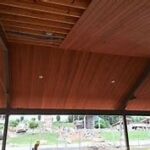When it comes to breathing life into interior spaces, few materials can rival the timeless elegance and versatility of wood veneer. This thin slice of nature doesn’t just serve as a stunning aesthetic element; it offers an array of practical benefits that can transform any space into a masterpiece.
Whether you’re looking to add warmth, texture, or sustainability to your home or office, wood veneer stands out as a superior choice. It captures the rich beauty of natural wood while providing an opportunity to innovate creatively in ways solid lumber often can’t.
From budget-friendly upgrades to cutting-edge design flexibility, wood veneer opens doors to endless style possibilities. Get ready to explore how this exceptional material can elevate the spaces you cherish while harmonizing quality with affordability and environmental consciousness.
Enhances Aesthetic Appeal in Design
Wood veneer is a game-changer when it comes to elevating the visual appeal of any interior space. With its ability to mimic the depth and intricate grain patterns of solid wood, it offers a high-end look that can effortlessly transform plain surfaces into captivating focal points.
Whether you’re aiming for a sleek, modern vibe or a classic, rustic charm, wood veneer delivers. It comes in a stunning variety of species, colors, and finishes, making it easy to tailor designs that perfectly complement your style and vision.
Beyond its natural beauty, wood veneer also allows designers to experiment with creative patterns and inlays that would be challenging to achieve with solid wood. This versatility inspires bold, unique designs that can breathe individuality into residential and commercial settings alike.
What’s more, veneer sheets can be applied to nearly any flat surface, such as cabinetry, walls, or furniture, offering a cost-effective way to infuse elegance and sophistication into every corner of your space. With wood veneer, achieving a luxurious ambiance doesn’t have to come with a hefty price tag or the limitations of heavier, solid materials.
Cost-Effective Solution for Luxurious Look
In the realm of interior design, achieving luxury without breaking the bank is a dream come true, and wood veneer makes this dream incredibly attainable. Offering all the opulence of solid wood but at a fraction of the cost, it allows for exquisitely designed spaces within a reasonable budget.
This affordability is due to the nature of veneer itself—thin sheets of high-quality wood bonded to a core panel. This innovative method uses less precious wood while delivering the same rich, impressive appearance.
On top of that, wood veneer is remarkably efficient in its application process. It is lightweight and easy to install, which reduces labor costs and time, giving homeowners and designers more flexibility to invest resources in other areas of a project.
With wood veneer, even expansive projects such as custom cabinetry or extensive paneling become financially feasible. You can experiment with various wood types and finishes that may have been previously out of reach without sacrificing quality or style.
Ultimately, wood veneer provides a savvy, cost-effective pathway to a sophisticated, high-end look, making it a go-to choice for those eager to blend luxury with practicality.
Sustainability and Environmental Benefits
In today’s eco-conscious world, making sustainable choices in design has become all the rage, and wood veneer stands out as an environmentally friendly option. This material significantly reduces the demand for solid wood, which, in turn, helps conserve hardwood forests.
By utilizing thin slices of wood, veneer maximizes the utility of a single log—creating more with less. This efficient use of resources means that low-impact production methods can yield impressive design results, making veneer an environmentally responsible choice.
Furthermore, when sourced responsibly, wood veneer can contribute to sustainable forestry practices. Many suppliers adhere to certifications like FSC (Forest Stewardship Council), ensuring that their products support healthy forest ecosystems and responsible resource management.
Additionally, the manufacturing process of veneer generates less waste compared to solid wood production. This reduced waste, paired with lower energy consumption during production, means a smaller carbon footprint, benefiting the planet while beautifying our homes.
Ultimately, choosing wood veneer aligns design decisions with environmental consciousness. It provides an opportunity for homeowners and designers to create spectacular interior spaces without compromising long-term ecological health.
Durable Material for Long-Lasting Beauty
When it comes to longevity and resilience, wood veneer proves to be an outstanding choice. Despite its delicate appearance, this material is surprisingly robust, offering a durable option for surfaces that endure daily use.
Wood veneer is applied to stable core materials, such as plywood or MDF, which enhance its strength and resistance to warping over time. This combination ensures that veneer surfaces maintain their beauty and integrity in various conditions.
Furthermore, wood veneer provides flexibility in maintenance and repair. Scratches or minor damages are easier to rehabilitate compared to solid wood, often only requiring a simple refinishing process to restore its original allure.
The finish applied to veneer surfaces also plays a crucial role in its durability. High-quality finishes protect against moisture, stains, and wear, further enhancing the lifespan of the material and preserving its attractive appearance.
Choosing wood veneer not only ensures a visually appealing environment but also promises a lasting investment. With proper care, veneer provides extended enjoyment of its natural beauty, making it a highly reliable material for creating enduring, elegant spaces.
Enhanced Versatility in Design Options
Wood veneer truly shines when it comes to versatility, opening up a world of creative possibilities for interior design enthusiasts. Its adaptability lies in its ability to accommodate a wide range of styles, from traditional to contemporary, allowing it to blend seamlessly into any aesthetic.
The array of species and finishes available means designers can experiment with different textures, tones, and grains, tailoring each project to specific tastes or themes. Whether you desire the exotic allure of zebrawood or the classic elegance of walnut, veneer offers endless variety.
Furthermore, wood veneer’s thin, flexible sheets can be applied to numerous surfaces and foundations, including curved and irregular shapes. This flexibility enables intricate designs and innovative configurations that solid wood might not accommodate as easily.
Also, veneer’s compatibility with other materials like glass, metal, and stone allows designers to create striking contrasts and harmonious combinations, enhancing both the visual and tactile experience of a space.
With wood veneer, the only limit is imagination. Its remarkable versatility ensures that every design is not only visually stunning but also uniquely personal, offering tailored solutions that bring interior visions to life with style and finesse.
Customization and Unique Design Opportunities
One of the most exciting aspects of using wood veneer in interior design is its potential for customization. This material allows designers and homeowners to craft spaces that are not just aesthetically pleasing but also deeply personal and original.
Tailor-Made Visuals
With wood veneer, the possibilities for unique patterning and coloration know few bounds. Designers can mix different veneer species to create stunning, customized visuals that cater to individual preferences. Whether it’s a herringbone pattern, marquetry, or a bespoke geometric design, veneer provides the canvas for artistic expression.
Coupled with this, thanks to modern technology, wood veneer can be precision-cut to match exact specifications, making it ideal for custom installations. This precision ensures that every piece fits perfectly, contributing to the overall harmony and flow of the design.
Expressive Personalization
For those who seek distinctiveness, wood veneer offers an opportunity to incorporate personalized elements into the design. Engravings, inlays, or even logos can be added, giving each piece a unique story and a special connection to its environment.
By embracing the customizable nature of wood veneer, spaces are transformed into true reflections of personal style and creativity, celebrating the individuality of those who call these spaces home.

Integration of Wood Veneer with Modern Design Trends
In the fast-paced world of interior design, staying ahead of trends without sacrificing timeless appeal can be a challenge. Wood veneer brilliantly bridges the gap between contemporary trends and enduring style, making it a sought-after choice for modern interiors.
Seamless Blending with Minimalism
The sleek and subtle appearance of wood veneer aligns perfectly with minimalist design principles. Its ability to cover large areas without appearing overwhelming makes it an ideal candidate for minimalistic spaces that thrive on clean lines and uncluttered aesthetics.
Additionally, the natural warmth and texture of veneer add a layer of coziness to minimalist interiors, preventing them from feeling too stark or sterile. This balance enhances the inviting nature of any modern living area.
Beyond minimalism, wood veneer adapts to a variety of other trends such as biophilic design, which emphasizes the connection between nature and indoor environments. Incorporating wood veneer introduces organic elements that bring tranquility and a sense of the outdoors into contemporary spaces.
The versatility of wood veneer ensures it remains a staple in evolving design trends, offering a sophisticated approach to modern interiors that feel both current and classic.
Conclusion – Elevating Interior Design with Wood Veneer
In summary, wood veneer stands out as a remarkable material in the interior design landscape, melding beauty with practicality. Its capacity to transform bland spaces into sophisticated havens is unmatched, offering a luxurious look without excessive costs. The affordability of wood veneer, without compromising quality, makes it accessible for a variety of design projects.
Another key point is, sustainability is at the heart of wood veneer’s appeal. By optimizing resource use and promoting responsible forestry practices, veneer helps create beautiful spaces while respecting our planet. It’s a choice that aligns aesthetic goals with environmental mindfulness.
Durability and versatility further underscore its value, providing long-lasting beauty and the ability to conform to any design style or surface. From intricate custom patterns to monumental simple touches, wood veneer caters to personalized design aspirations.
The material’s seamless integration with modern trends such as minimalism and biophilic design showcases its timeless nature and adaptability. Wood veneer effortlessly connects indoor environments with nature, offering spaces that are both stylish and calming.
In the ever-evolving world of interior design, wood veneer provides a unique combination of elegance and functionality. Its myriad benefits make it an invaluable tool for enhancing any interior setting. Thus, whether for a sleek modern home or a warm traditional office, wood veneer truly elevates design, making it both a prudent and inspired choice for those looking to enrich their spaces.


